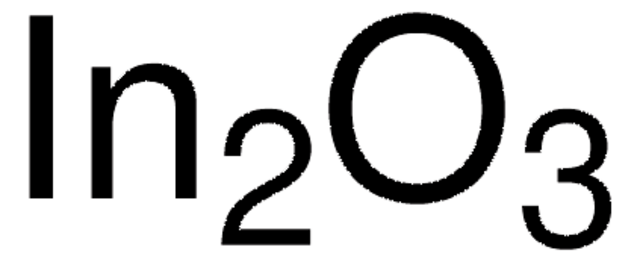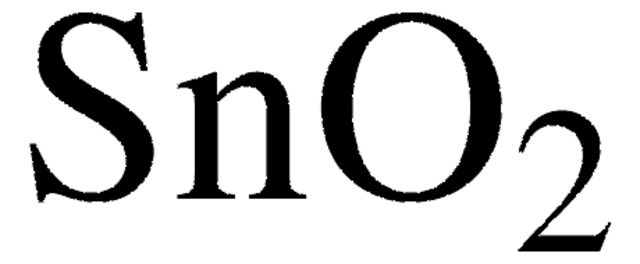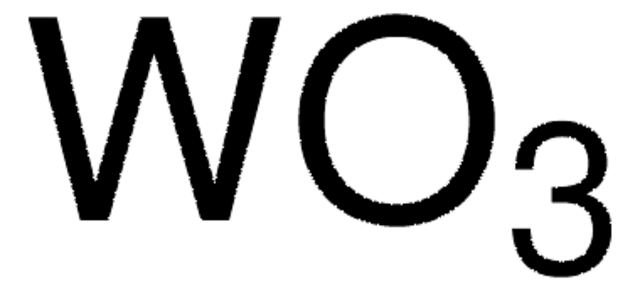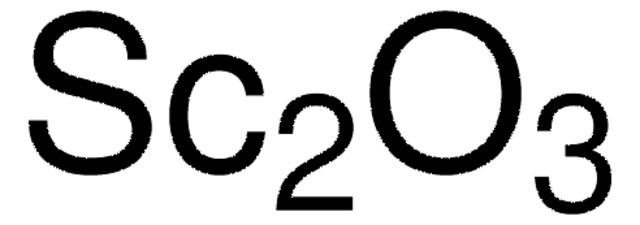289418
Indium(III) oxide
99.99% trace metals basis
Synonyme(s) :
Diindium trioxide, Indium sesquioxide
About This Item
Produits recommandés
Pression de vapeur
<0.01 mmHg ( 25 °C)
Niveau de qualité
Pureté
99.99% trace metals basis
Forme
powder
Pertinence de la réaction
reagent type: catalyst
core: indium
Densité
7.18 g/mL at 25 °C (lit.)
Application(s)
battery manufacturing
Chaîne SMILES
O=[In]O[In]=O
InChI
1S/2In.3O
Clé InChI
SHTGRZNPWBITMM-UHFFFAOYSA-N
Vous recherchez des produits similaires ? Visite Guide de comparaison des produits
Description générale
Application
- Comparative analysis on application conditions of indium (III) oxide-reinforced glasses in nuclear waste management and source transportation: A Monte Carlo study: This research explores the use of indium (III) oxide-reinforced glass for radioactive waste containment, highlighting its effectiveness and potential in nuclear waste management (ALMisned et al., 2023).
- Double-shelled hollow rods assembled from nitrogen/sulfur-codoped carbon coated indium oxide nanoparticles as excellent photocatalysts: Discusses the synthesis and application of indium oxide nanoparticles in photocatalysis, demonstrating significant enhancements in environmental cleanup technologies (Sun et al., 2019).
- Black indium oxide a photothermal CO2 hydrogenation catalyst: Investigates black indium oxide for its use in photocatalytic CO2 reduction, a critical process for sustainable energy and chemical synthesis (Wang et al., 2020).
- Material proposal for 2D indium oxide: This study proposes two-dimensional indium oxide, discussing its material characteristics and potential applications in electronics and optoelectronics (Kakanakova-Georgieva et al., 2021).
- Purification of indium by solvent extraction with undiluted ionic liquids: Examines the processes of extracting and purifying indium using green chemistry approaches, contributing to more sustainable practices in materials processing (Deferm et al., 2016).
Code de la classe de stockage
11 - Combustible Solids
Classe de danger pour l'eau (WGK)
WGK 3
Point d'éclair (°F)
Not applicable
Point d'éclair (°C)
Not applicable
Équipement de protection individuelle
dust mask type N95 (US), Eyeshields, Gloves
Faites votre choix parmi les versions les plus récentes :
Déjà en possession de ce produit ?
Retrouvez la documentation relative aux produits que vous avez récemment achetés dans la Bibliothèque de documents.
Les clients ont également consulté
Articles
Spectral conversion for solar cells is an emerging concept in the field of photovoltaics, and it has the potential to increase significantly the efficiency of solar cells. Lanthanide ions are ideal candidates for spectral conversion, due to their high luminescence efficiencies and rich energy level structure that allows for great flexibility in the upconversion and downconversion of photons in a wide spectral region (NIR-VIS-UV).
Notre équipe de scientifiques dispose d'une expérience dans tous les secteurs de la recherche, notamment en sciences de la vie, science des matériaux, synthèse chimique, chromatographie, analyse et dans de nombreux autres domaines..
Contacter notre Service technique










